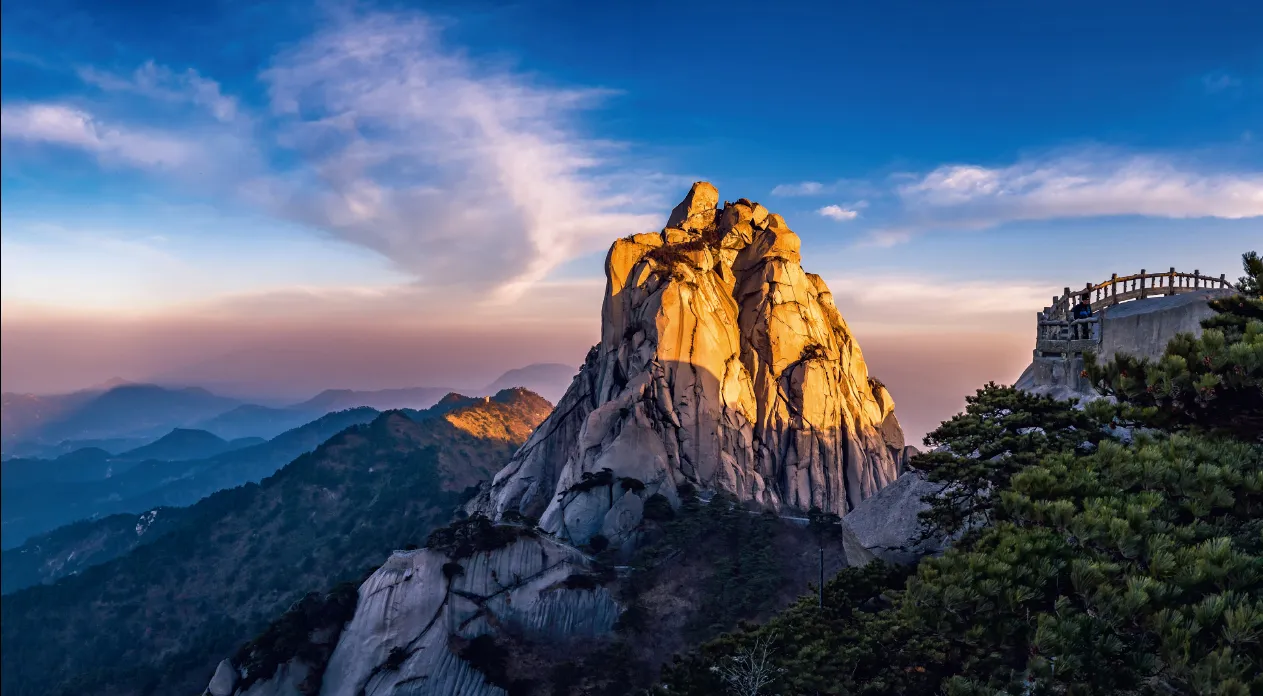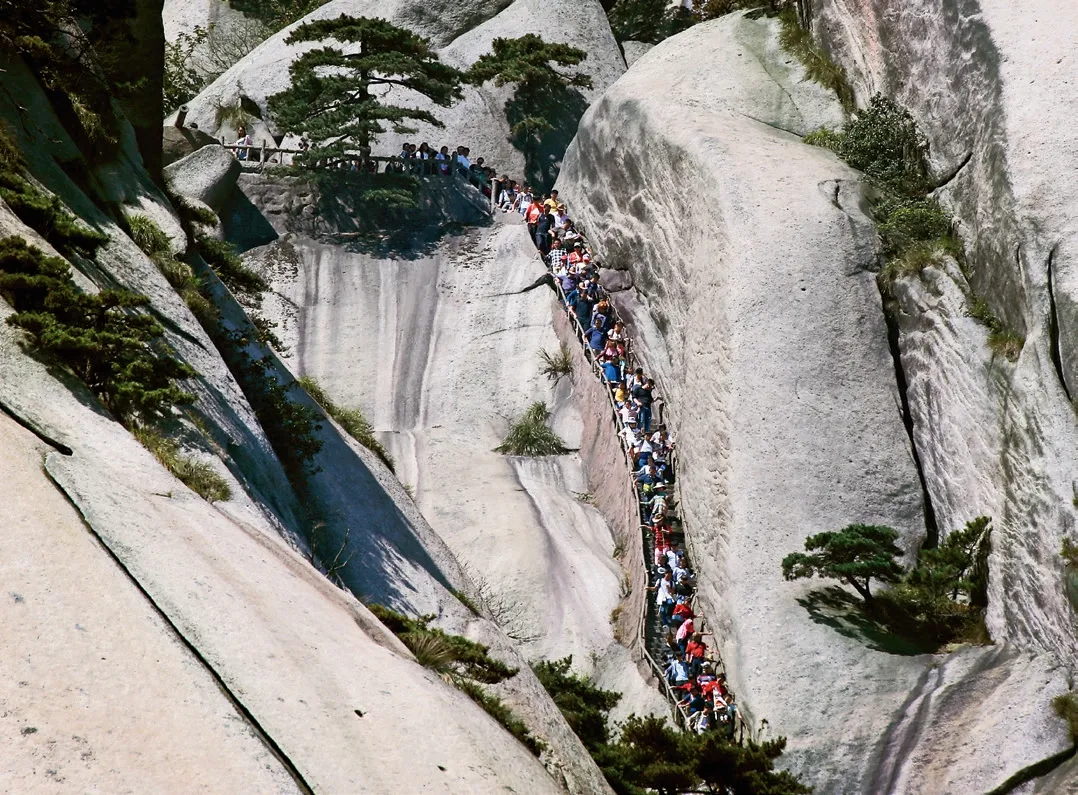Tianzhu Mountain:A GraniteElevated Forest
By staff reporter MENG JIAXIN
Tianzhu Mountain was named the “southern mountain,” one of the holy mountains in China,in the reign of Emperor Wudi of the Han Dynasty (202 BC-AD 220),offering visitors a blend of natural beauty and human legacies.

The summit of Tianzhu Mountain is shaped like the tip of a bamboo shoot.
THE Tianzhu Mountain is located in the west of Qianshan City of east China’s Anhui Province,with a total area of about 413 square kilometers.It is named after its main majestic peak,which resembles a pillar towering up into the sky,and is renowned for its strange-shaped rocks,beautiful water bodies,and mysterious caves.Meanwhile,the Tianzhu Mountain Scenic Area has been recognized as a World Geopark,National 5A Tourist Attraction,National Forest Park,National Natural and Cultural Heritage Site,and is seen as “the most stunning granite landscape in the East” by geologists.Tianzhu lies at 30° north latitude and boasts four distinct seasons,a mild climate,a rich collection of species,and high forest coverage.
Not only is the Tianzhu Mountain endowed with spectacular natural scenery,it also has an abundance of historical sites.In 106 BC,Emperor Wudi of the Han Dynasty visited the mountain and awarded it the title of “southern mountain,” one of the holy mountains in China.In the Sui Dynasty (581-618),Emperor Yangdi expanded the territory and renamed Mount Heng in Hunan Province as the southern mountain,but Tianzhu was still honored as the ancient southern mountain.Chinese emperors through the ages have made ceremonial offerings or sent officials to offer tributes to Tianzhu.In addition,generations of renowned writers and artists have visited the mountain,and nearly 400 cliff carvings from these visits have survived.
Tianzhu Peak
The Tianzhu Peak,at an altitude of 1,489.8 meters,is the highest peak in the Tianzhu Mountain Scenic Area.The steep summit is shaped like the tip of a bamboo shoot,so Tianzhu Peak is also figuratively called “the tip of a bamboo shoot.” The Tianzhu Peak towers over all the other peaks in a rather large radius,and as Anhui has a cloudy climate,the peak tends to be blanketed in clouds for about half the year.Tang Dynasty (618-907) poets Li Bai and Bai Juyi wrote poems admiring the majesty of the Tianzhu Peak,which is so dangerous and treacherous to climb that it is closed to tourists.Visitors can view it from the adjacent Tianchi Peak.
historical sites
Not only is the Tianzhu Mountain endowed with spectacular natural scenery,it also has an abundance of historical sites.
The Tianchi Peak,the second highest peak in the park,is 1,426 meters above sea level.The top of the peak is split into three parts,which are connected by two narrow stone slabs.As the slabs function as a bridge,people called them “Duxian bridge,” literally meaning “bridge for the immortals.” After crossing the bridge,visitors reach a platform of less than 10 square meters from where they can take in the majestic beauty of the adjacent Tianzhu Peak.Looking down,the surrounding scenery is magnificent.This summit is also an ideal place to view sunrise,a sea of clouds,the sun’s afterglow,as well as the Alchemy Lake which sits on the mid-mountain.

Tourists are climbing up the famous Hundred-Step Cloud Stairway.
Besides Tianchi,the Penglai Peak is also a good spot to view the Tianzhu Peak.Penglai is 1,350 meters above sea level,with a view of the Tianchi Peak to the south and the Tianzhu Peak to the north.The west,south,and north sides of the peak are steep and sharp.The path to the top of the peak is narrow and dangerous,with a length of more than 100 meters and a width only two or three meters.Today,though rails have been installed to ensure hikers’ safety,the path is still so narrow that it is like walking on the edge of the cliff.Ancient pine trees on the outside of the rails help to ease visitors’ anxiety of height to some extent.The summit peeps out from a sea of cloud from time to time.
The Alchemy Lake at the foot of the Tianzhu Peak is an artificial lake.It is 1,100 meters above sea level and covers an area of nearly 30,000 square meters,with a water storage capacity of 80,000 cubic meters.Reflection of cliffs and pines in the clear turquoisecolored water adds a sense of vitality to the calm water.Canoeing on the lake is allowed and provides a peaceful and refreshing interlude.The lake’s name dates back to the end of the Eastern Han Dynasty (25-220),when a noted Taoist priest used to collect herbs and make medicine for immortality here.
To the southwest of Tianzhu Peak is Feilai Peak,the third highest peak of the scenic area,at 1,424 meters above sea level.There is a beret-shaped stone perching alone on the summit.It is about 10 meters long,with a diameter of 100 meters.Legend has it that 2.6 billion years ago,where Tianzhu is today,was a vast expanse of sea,home to demons that were threatening people’s lives.Legend has it thatTaishang Laojun(Supreme Master),honorific title forLaozi,the highest Taoist deity,used his magic powers to bury the demons on Feilai Peak under a stone borrowed from the Dragon King of the East Sea.The eye-catching Feilai stone stands at the peak’s summit.
Cultural Valley
There is a 1.5-kilometer valley in Tianzhu,noted for its cultural legacies.The wide valley is dotted with trees,ancient temples,and clear streams.Many historical and cultural sites can be found along the creek.
There is a natural stone cave in the valley,with a big stone shaped like a sleeping bull,aptly named Stone Bull Cave.Huang Tingjian,a great literati of the Song Dynasty (960-1279),once built a study here,and Wang Anshi,a prestigious politician and literati of the Song Dynasty,left verses behind after his stay. Cliff inscriptions in the cave were written in various Chinese calligraphy and literary styles dating back to all ages from the Tang Dynasty to the modern era.
Generally speaking,the section of the river above the Stone Bull Cave is the upper stream,called Chanchan Creek;the section around the Stone Bull Cave is the midstream,called Stone Bull Creek;and the downstream is called Valley Spring,which is the most popular section among them.
must-see attraction
Remains of ancient military facilities can also be found here.For those thrillseekers and military fans,it is a must-see attraction.
The Valley Spring was named by Huang Tingjian,and it is seen as a valley of culture.When Huang was posted to the area he became obsessed with the scenery of the Valley Spring.He often read and wrote poems on the rocks by the spring,and drew water from the spring to make tea.Wang Anshi,during his term in office,also often came here to visit.Nowadays,the cliff carvings of their poems still remain visible.In a section of about 200 meters around the Valley Spring,there are over 280 inscriptions from every historical era.Most of the content reflect writers’ love for the mountains and admiration for natural beauty.The number and concentration of cliff carvings in the area are rarely seen on China’s mountains.

The Alchemy Lake is nestled serenely among the surrounding arms of Tianzhu hills.
Hundred-Step Cloud Stairway
In the Tianzhu Mountain Scenic Area,there is a long stone stairway built on a steep and dangerous cliff.It consists of more than 130 steps and has a 70-degree incline.This thrilling journey is located in an ancient military pass.It is often blanketed with cloud,so was given the name “hundred-step cloud stair.”
A story about this stairway has it that at the end of the Southern Song Dynasty (1127-1279),Liu Yuan,an Anhui native,led 100,000 troops and stationed them on the Tianzhu Mountain for almost 18 years,in order to resist the invading Yuan army.Liu’s headquarters is located above the cloud stairway.Here the terrain is strange and dangerous,making it a natural military fortress,which is easy to defend but difficult to attack.
In 1998,the management committee of the Tianzhu Mountain Scenic Area restored the stairway on the original site.Remains of ancient military facilities can also be found here.For those thrillseekers and military fans,it is a must-see attraction.As the trip is quite challenging,most hikers stop several times and take breaks along the way.On the way down,tourists have to hold onto the railings and safety ropes and descend slowly step by step.

